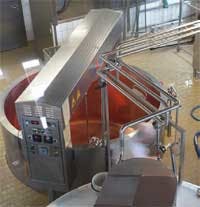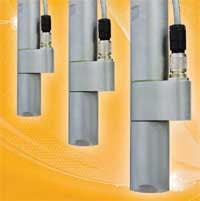When selecting a motor for automated technology, the small size and powerful operation of air motors makes them an easy choice. A typical air motor is just one-third the size and one-fifth the mass of an equivalent electric motor, making air motors the choice for most handheld machines and stationary equipment.
However, speed regulation is often an issue, so Deprag Schulz GmbH, Amberg, Germany, developed an innovative speed regulator for their air motors. Combined with smart sensor technology, the air motor will always hold the desired preset speed.
According to product manager Dagmar Dbbelde, “It is characteristic for an air motor to operate under many changing loads. When operated without load, the motor runs at its rated noload speed. If the load increases, the motor’s speed decreases. So an air motor can be operated at approximately 15% to 100% of its nominal speed, depending on its load requirement.”
This can cause problems. For example, in an agitator in a chemical mixer, a constant speed is required for accurate production. If the viscosity of the mixture or its volume changes, an undesirable speed change occurs. When confronted with this problem from a customer, Deprag went to work on a new speed regulator.
Simple and reliable operation
The controlledspeed air motor for the agitator consists of three components. The motor is based on Deprag’s stainlesssteel Advanced Line, which meets oil-free operation needed in clean room environments for hygiene and safety. When equipped with the sensor and special valve, the motor offers innovative speed control. Additionally, the regulator electronics allow installation into a user’s control box. Finally, an operator friendly LCD is used for simple and uncomplicated speed value selection.
The new speed regulator relies on a non-contacting speed sensor integrated directly into the air motor, between the vane air motor and gearing. The sensor monitors the motor’s actual operating speed, which is transferred as a digital signal to the regulator. The operator uses an LCD interface on the agitator controller to enter the desired nominal speed, and the regulator compares the two values. Variation between the actual speed and nominal speed causes a proportional valve to be actuated to increase or decrease air flow to the motor and, therefore, its speed. The result: The air motor operates consistently within the required speed range.
The speed regulator is used with the stainless steel 67-028R air motor. The nominal speed of this 1200-W motor is 1250 rpm, the no-load speed is 2500 rpm, and the nominal torque is 9.2 Nm — all based on an operating pressure of 6 bar. The air motor operates the agitator for mixing fluids ranging in viscosity from 1 to 300 mPa. It maintains its speed within the required tolerance independent of viscosity or volume fluctuations of the mixture in the receptacle.
Suitable for many applications
Dbbelde explains that the new regulator can be used with other applications. “Some processes focus more on the regulator speed and others on the accuracy of the regulator,” Dbbelde says. “Our speed regulator can operate for both of those applications and is therefore universally functional.”
In the case of the agitator, it is more important to obtain high speed accuracy than to adjust the speed as fast as possible when fluctuations occur. According to its preset value, the regulator keeps a constant speed of ±5 rpm and self-adjusts the speed — within maximum 2 sec — to the nominal value if any load changes occur.
The Deprag speed-regulator system proves its accuracy within varying speeds. A vane motor with very low speed can be reliably regulated. The speed is evaluated from a full rotation to 132 of a rotation and regulated to correspond with the nominal value.
The speed regulator can also hold a constant speed up to 80,000 rpm . The proportional regulator valve of the air motors offers precise control with high resolution. The output signal for the valve control is 0-10 V; the resolution of the regulator voltage is 2.5 mV.
For more information, contact Dagmar Dbbelde at +49 9621 371-343 or [email protected] or visit www.deprag.com. In the U.S., contact Lori Logan ([email protected]) at (800) 433-7724, Ext. 3806 or visit www.depragusa.com.
About the Author

Leaders relevant to this article:


